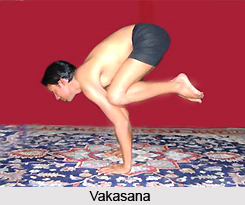 Vakasana is a cultural yoga asana where the practitioner assumes a pose resembling the stance of a crane. Vaka means crane in Sanskrit, and the name of the asana translates to the crane-pose. It is often used interchangeably with Kakasana.
Vakasana is a cultural yoga asana where the practitioner assumes a pose resembling the stance of a crane. Vaka means crane in Sanskrit, and the name of the asana translates to the crane-pose. It is often used interchangeably with Kakasana.
This asana is an arm balancing asana in which hands are planted on the floor, shins rest upon upper arms, and feet lift up. It is beneficial for a number of back problems, and also strengthens the muscles of the arms.
Practice of Vakasana:
•Sit, placing the soles on the ground. Maintain some distance between both the knees and place the palms on the ground, stretch out the fingers. Place both the knees on respective side above elbows.
•Now slowly bend forward so that both legs are raised up and balance above the ground on the hands with the help of knees. Gaze in front.
•Maintain and then return to the original position. Slowly place the soles on the ground.
•The practitioner can hold this posture for at least 20 seconds to a minute as per capacity while breathing normally and repeat it once or twice consecutively.
Benefits of Vakasana:
•Muscles and nerves of the arms are strengthened.
•The chest becomes strong.
•This is beneficial in lumbar spondylitis.
•Wrists attain power with the practice of this asana.
•It strengthens the biceps muscles.
•It strengthens the shoulders and hands.
•It toughens the core muscles and organs of the abdomen.
•It opens the groins.
•It stretches the upper back and increases the flexibility and elasticity of the spine.
•Vakasana improves sense of balance.
•It also improves coordination, weak back and poor posture.
•It improves concentration.
•This asana also helps in building self-confidence.
Precautions in practice of Vakasana:
•Since this is a balancing pose, care must be taken while practicing this asana. Beginner`s should practice this asana for short durations initially; a longer duration may cause numbness, and also a loss of balance which can lead to injury as the body will take time to acquire the required balance.
•While practicing this asana, one has to keep the neck straight to avoid sprains and stains.
•Those suffering from cervical spondylitis should not practise this asana.
•Pregnant women and those suffering from carpal tunnel syndrome should also not practice this asana.




















